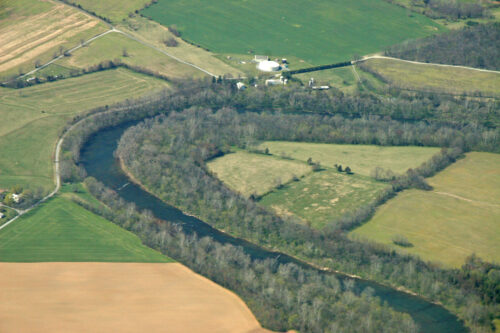Forests are highly important and effective at keeping Virginia’s waters clean. Trees and forests near streams and waterways are even more important. Tree roots hold tightly to soil, keeping it in place and preventing soil movement or erosion. The tree canopies and the leaves on the ground intercept rainfall and slow it down allowing the excess nutrients or other pollutants to be filtered out of the water. Streamside forests provide shade that keeps water temperatures lower and more suitable for aquatic life in the stream. Leaves that fall in the water provide food for small insects and other organisms that in turn are food for fish and other stream life. Trees along streams and adjacent areas allow a place for floodwaters to dissipate, slow, and drop sediment. Finally, streamside forests provide excellent habitat – food, cover, nesting, and travel corridors – for wildlife.
Two types of streamside forests are of particular importance: streamside management zones and riparian forest buffers.
Streamside Management Zones
 Timber harvesting is an important part of Virginia’s economy, providing income to landowners, employment for loggers, and wood to support a vibrant forest industry. Best Management Practices (BMPs) are activities utilized by loggers that reduce the chance of soil erosion that may enter waterways. Streamside Management Zones (SMZs) are areas adjacent to streams where all, or a portion of the trees are retained when the surrounding timber is harvested. These uncut or partially-harvested areas provide the benefits of stabilizing soil, capturing sediment, and furnishing shade and cover.
Timber harvesting is an important part of Virginia’s economy, providing income to landowners, employment for loggers, and wood to support a vibrant forest industry. Best Management Practices (BMPs) are activities utilized by loggers that reduce the chance of soil erosion that may enter waterways. Streamside Management Zones (SMZs) are areas adjacent to streams where all, or a portion of the trees are retained when the surrounding timber is harvested. These uncut or partially-harvested areas provide the benefits of stabilizing soil, capturing sediment, and furnishing shade and cover.
Riparian Forest Buffers
 Establishing new riparian forest buffers on open land where they don’t currently exist, or expanding existing buffers provide many of these benefits. Examples are streams that flow through farm or pasture land, lawns, or commercial or industrial areas. Converting these open lands to new forests by tree planting or natural seeding will check erosion, soil movement, provide shade and habitat, and slow floodwaters.
Establishing new riparian forest buffers on open land where they don’t currently exist, or expanding existing buffers provide many of these benefits. Examples are streams that flow through farm or pasture land, lawns, or commercial or industrial areas. Converting these open lands to new forests by tree planting or natural seeding will check erosion, soil movement, provide shade and habitat, and slow floodwaters.
Learn more about planting riparian forest buffers.
Your local DOF forester can help guide you through the timber sale process and assist you with incorporating proper BMPs to protect water quality during the implementation of a forestry practice on your property, as well as provide guidance about planting riparian forest buffers.
Additional Resources
| Image | Title | ID | Description | Content Type | View | hf:tax:document-category | hf:tax:Media |
|---|---|---|---|---|---|---|---|
 | Riparian Forest Buffers – Forests on the Water’s Edge | P00140 | Publication is the effort of the Chesapeake Bay Program, including multiple states within the Chesapeake Bay Watershed, to educate the community leaders and the public about the benefits of riparian forest Buffers, their importance to watersheds for air quality, water quality and fish and wildlife habitat, forest Buffer losses and how we manage growth in riparian zones, how to maintain quality riparian forest Buffers, efforts in riparian forest restoration, and what you can do for forest Buffers. Printed copies available. | Publication | View | watershed | publication |
| Virginia’s Forestry Best Management Practices for Water Quality: Field Guide | P00134 | Technical field guide provides a convenient pocket instruction guide for timber harvesters to protect water quality when harvesting timber and comply with applicable laws. Printed copies available. | Publication | View | water-quality | publication | |
 | Virginia’s Forestry Best Management Practices for Water Quality: Technical Manual | P00104 | Technical guide (5th edition) provides detailed instruction for timber harvesters to protect water quality when harvesting timber and comply with applicable laws. Printed copies available. | Publication | View | water-quality | publication |
 | Why Plant Forest Buffer? – Planting Riparian Forest Buffer is Real Forestry | FT0013 | Forestry topic information sheet emphasizes the importance of riparian Buffers to protect waterways, including what are riparian Buffers, riparian Buffer implementation, and cost-share programs available, such as the Conservation Reserve Enhancement Program (CREP). | Publication | View | watershed | publication |
Contact Us
Your local DOF forester can help guide you through the timber sale process and assist you with incorporating proper BMPs to protect water quality during the implementation of a forestry practice on your property, as well as provide guidance about planting riparian forest buffers. Contact your local DOF forester.
For more information or questions, e-mail us or use our contact form.
